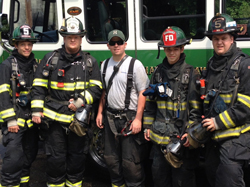
| Archives/Subscribe | Printer Friendly | Send to a Friend | Advertise | NYS Fire Chiefs | Size Up | September 2015 | |||||
Why Are These Firefighters Smiling?
By Jerry Knapp  Why are these firefighters smiling? They just participated in simulations to provide data for the latest Underwriters Laboratory study on interior and exterior fire attack for house fires! Underwriters Laboratories has a $1.5 million grant to determine the best ways to attack house fires (safest for firefighters and best for occupants) using interior and exterior streams and these firefighters are part of it! The members of the Lady Warren Hose Company of the Haverstraw Fire Department stretched a hoseline off their rig to the front door and pushed the line in extinguishing the simulated fire. Steve Kerber, who is leading the study, needs to determine the average time it takes to get an interior attack line in service. 25 firefighters and officers from around the United States, as well as chiefs from Ireland, Australia, Canada, Netherlands, and Germany, serve on the technical panel that is assisting Kerber in the research. I will be participating as a member of the Rockland County Fire Training Center. U.S. fire departments from FDNY to Seattle and Houston to Milwaukee are doing the same hose stretches and sending Kerber their data. It took the Lady Warren members under the leadership of Captain Charlie Prevot a total of three minutes and 10 seconds to stretch a 200-foot 1¾-inch preconnect, don SCBA at the door, and push the flowing line into a burn building, down the hallway, and out the door leading to the stairs. This excellent operation was possible due to their high skill level resulting from constant training. What does this mean to you at your next fire? In previous studies via numerous live full scale burns, Kerber has measured an average time of 100 seconds from the time your firefighters open the front door until flashover in a one-story ranch house (fire in the living room). It is 200 seconds in a 2½-story home. The amount of air available to a house fire is what controls the rate of fire development; more air means faster flashover. It means the difference between life and death to you! So, you enter the house for a search hoping the line will get to the fire soon, you make it to the bedrooms, and you are searching... the engine company was not skilled in getting water on the fire and it went to flashover. You were caught in it and burned over 75 percent of your body. When your face piece melted (at 400 degree Fahrenheit) you pulled it off, inhaled the 2,000 degree Fahrenheit air temperatures of flashover, and died. The FAST team recovered you, but it was too late. It was a really nice funeral, with fire trucks, bagpipers... the whole deal. Theoretical, you ask? Read the NIOSH report (#99F-21) about the Cherry Road line of duty deaths. What about your gear? For thermal protection, it is rated for 17 seconds of a flashover condition and that includes transmitting heat to your skin to achieve a second degree burn. This flashover was driven by the air you let in through the door you chocked open on the way in. Maybe it is time to change that practice. It traveled quickly pushing hot air and fire onto and into your gear. This was like a convection oven, or on the opposite side, winter wind chill. Your gear is tested in a static non-moving oven to get to that 17 seconds of protection. Moving air caused by the flashover will reduce those 17 seconds. Just like wind chill, only this is "burn chill." Example: 20 degrees with a 30-mile an hour wind is different than 20 degrees and no wind. In a house fire, 1,500 degrees with fast moving air burns you faster than 1,500 degrees with the air not moving. So why are these men smiling? They are confident they can get water on the fire quickly and effectively to prevent the previously described scenario. They also have seen the videos showing the results of Steve Kerber’s tests. They are smiling because they are awaiting the results of the latest live burns scheduled for January at the UL large fire facility in Northbrook, Ill. They and many firefighters can go and observe the live burns. Contact me for info. These live burns will include both interior and exterior streams on house fires. The latest laser technology will determine the best droplet size for interior fire attack (are we whipping the smooth bore nozzle too fast creating a fog pattern?). Pig carcasses will be used to determine the effects of pushing fire with exterior streams. Think this is all BS? You have a right to your opinion, but not a right to your own facts. So here’s something to think about. What are the house fire tactics that you use based on? Are there any facts, data, and real life test results or just passed down traditions? Our battlefield has changed. Smoke is now very flammable fuel that just needs air to kill us. Are we using 1960s tactics on a 2015 fire? Go to the UL website, watch the live burns, and see if what you believe is supported by facts, what tactics are now in question, and what is completely new! About the Author: Jerry Knapp is a 40-year veteran firefighter/EMT with the West Haverstraw Fire Department and is employed as a training officer at the Rockland County Fire Training Center. He is chief of the Rockland County Haz-Mat Task Force, a former nationally certified paramedic, and holds a degree in fire protection. Knapp is the author of the fire attack chapter in Fire Engineering’s Handbook for Firefighter I & II and numerous articles in fire service trade journals. He has presented training programs on a variety of topics, including modern house fires, fire attack operations, foam operations for engine companies, helicopter emergencies, decontamination procedures by engine companies, fast food restaurant fires, and terrorism/bomb awareness. Knapp serves on the technical panel for the latest Underwriters Laboratories FEMA grant to study the effects of interior and exterior streams at house fires. Visit the UL website for more information. |
|
New York State Association of Fire Chiefs www.nysfirechiefs.com |
1670 Columbia Turnpike | P.O. Box 328 East Schodack, NY 12063-0328 Phone: (800) 676-FIRE | (518) 477-2631 Fax: (518) 477-4430 |


